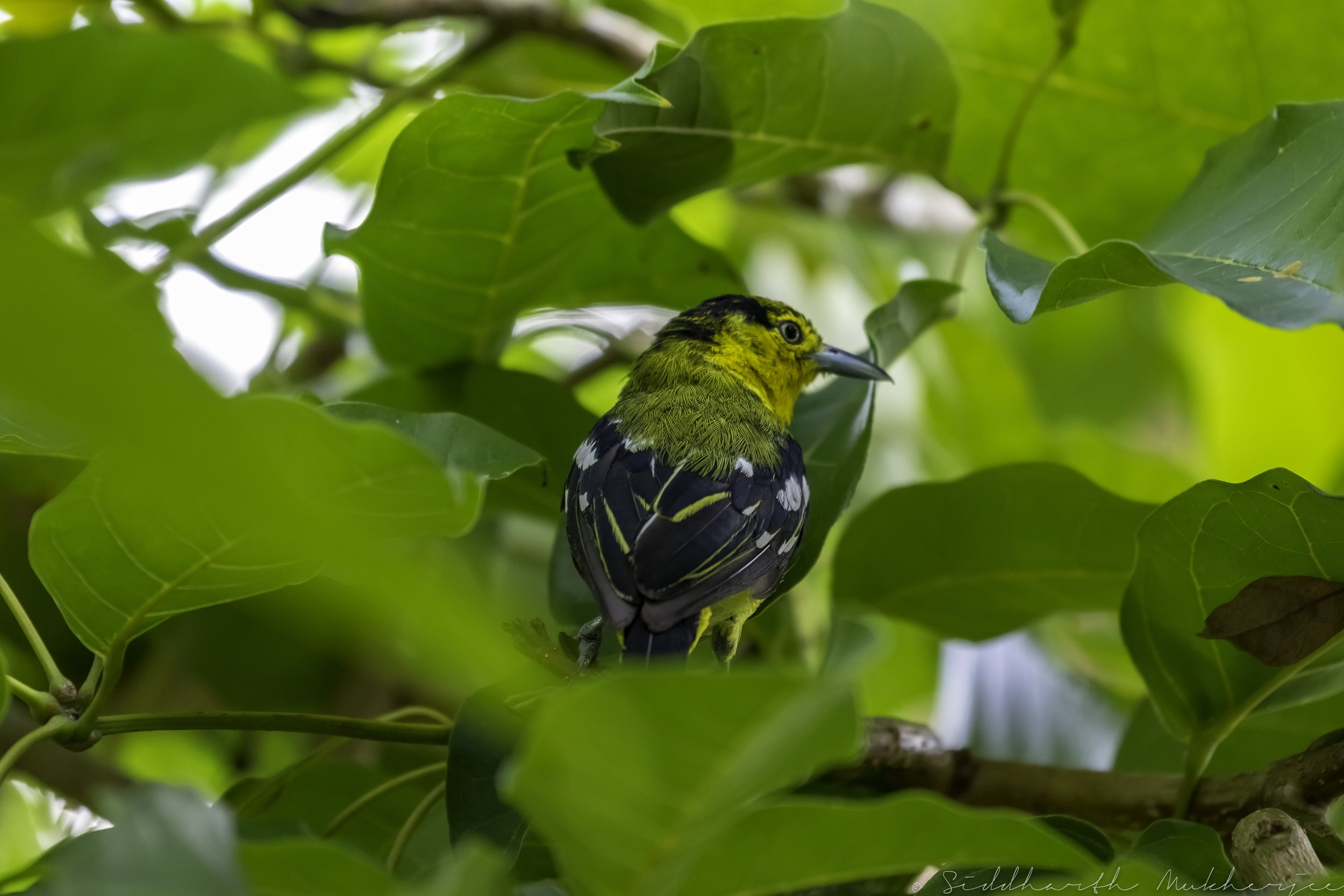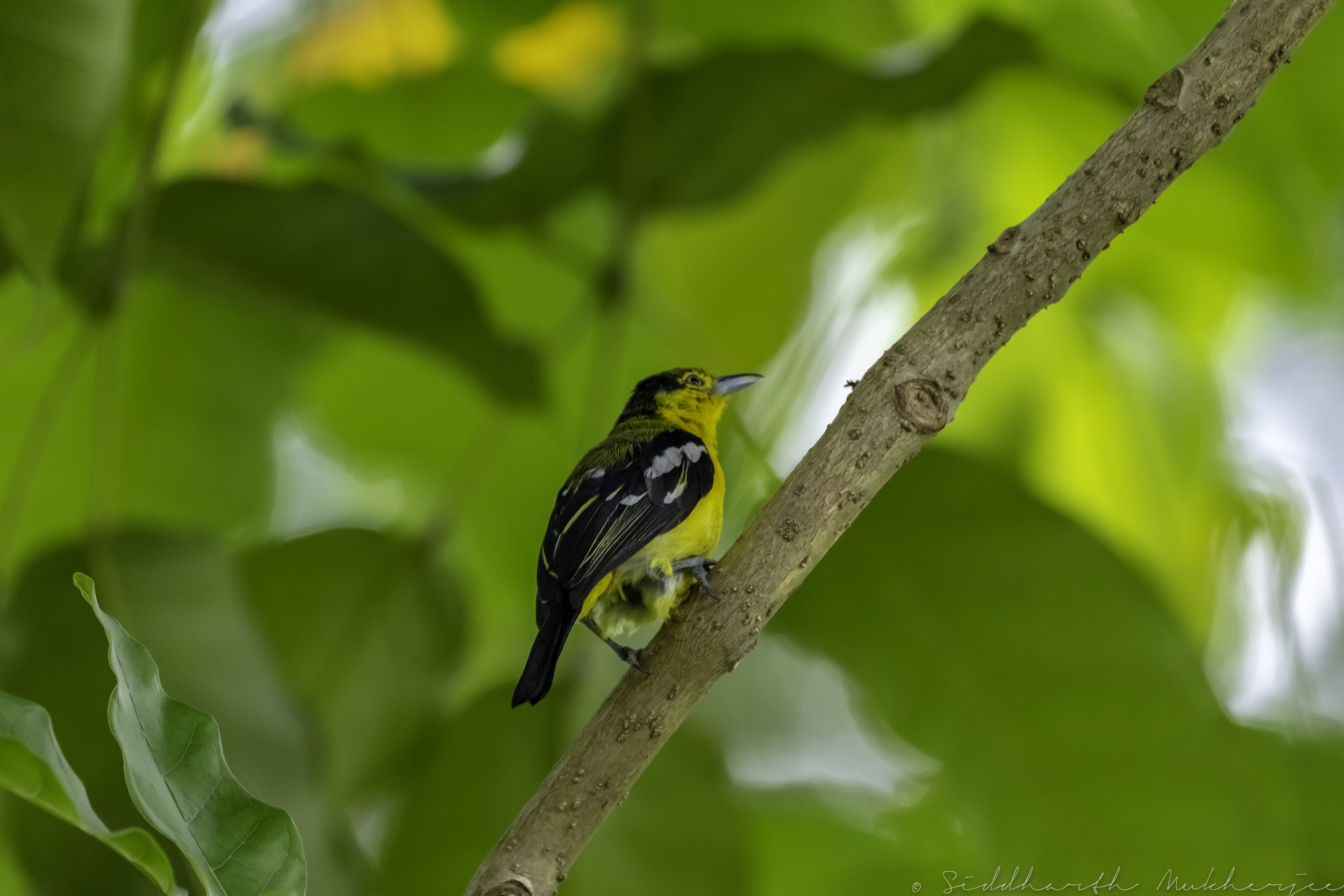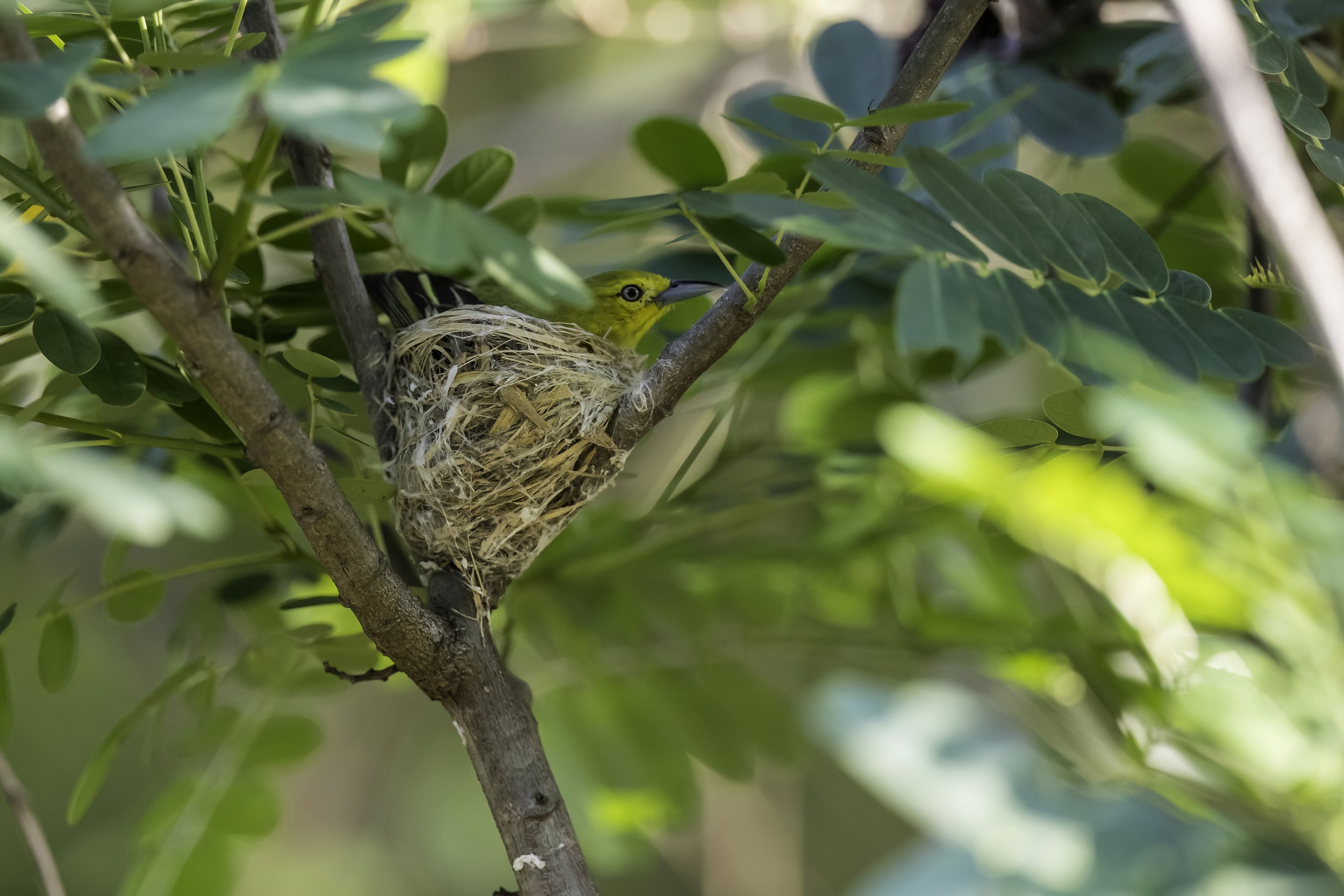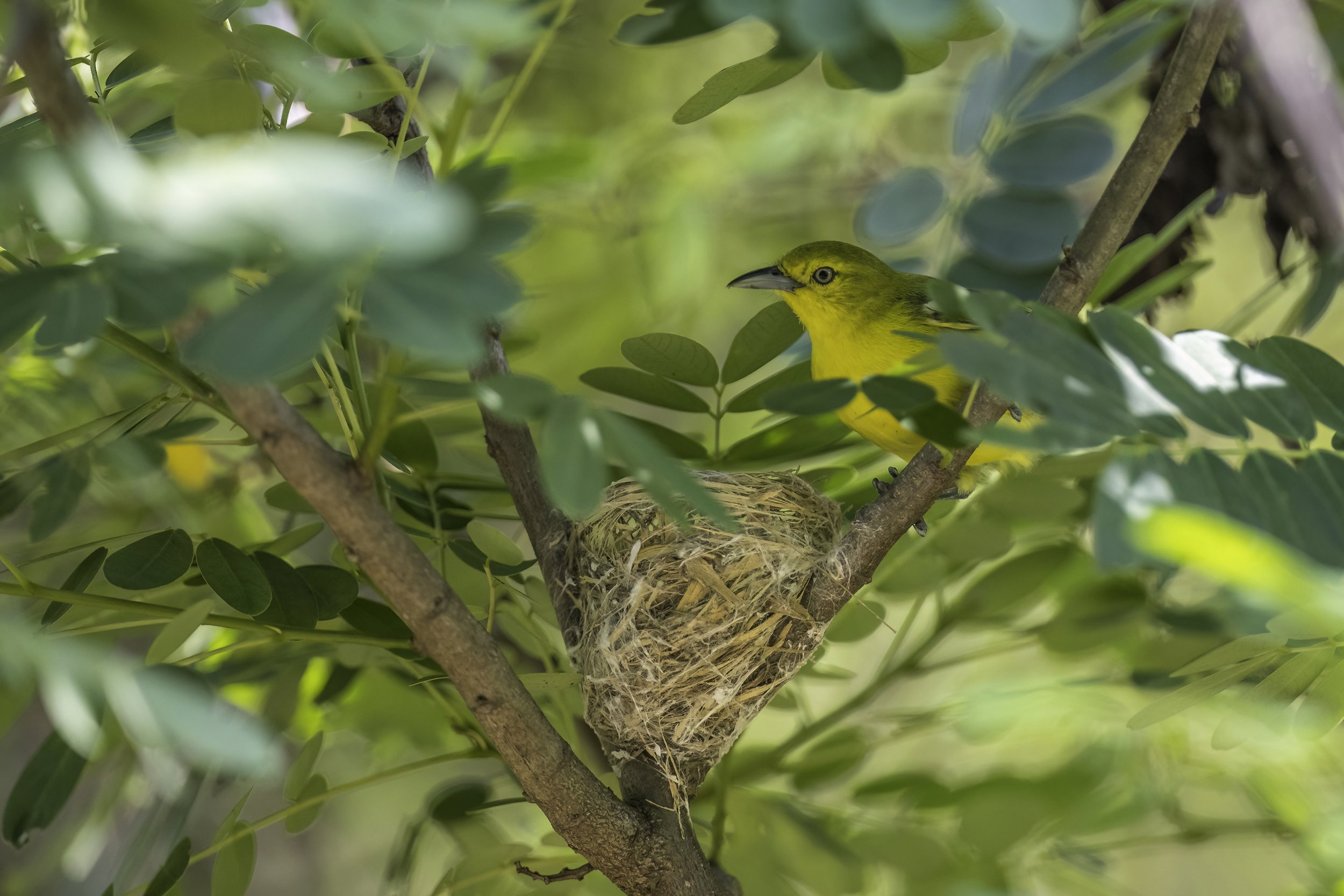Common Iora
Aegithina tiphia multicolor
Damagundam Forest Reserve, Edunagulapalle, Narsapur Forest, Ananthagiri Forest Reserve & Bishan Ang Mo Kio Park
The word Paigah, which means pomp and rank in Persian, was a title given by the second Nizam of Hyderabad to Nawab Abu'l Fateh Khan Tegh Jung Bahadur in appreciation of the royal services rendered by him. The Nawab was also conferred with the titles of Shams-ul-Umra, Shams-ul-Mulk, Shams-ud-Daula, Shams-ul-Umra which Means "The Sun among Nobles" and he became the founder of the Paigah family. Vikarabad, a historic town of the Paigah family, founded and named after the fifth Amir of the Paigahs, Sir Viqar-ul-Umra, was formerly a private hunting ground of the royals. Sir Viqar-ul-Umra’s jagirs Vikarabad, Dharur and the Ananthagiri Hills were known as the mini hill stations of the Deccan. The two major forest blocks Damagundam and Ananthagiri were the principal hunting grounds before being declared forest reserves.
Located in the central stretch of the Deccan Plateau, Telangana has sub-tropical climate and the terrain consists mostly of hills, mountain ranges, and thick dense forests covering an area of 27,292 km² (10,538 sq mi). The annual rainfall ranges between 1,100 mm to 1,200 mm and the annual temperature varies from 15 C to 45 C. The State is drained by a number of rivers which include Godavari and Krishna.
Telangana is endowed with rich diversity of flora and fauna. It has dense teak forests on the northern part along the banks of river Godavari. As per the Champion & Seth Classification of Forest Types (1968), the forests in Telangana belong to three Forest Type groups, which are further divided into 12 Forest Types. The State Government has taken up a massive greening programme, 'Telangana Ku Harita Haram' in the State to plant and protect 230 crore seedlings over a period of 4 years. This initiative aims at achieving the twin objectives of increasing the forest cover and reduce pressure on the existing forest resources, through massive community participation by Vana Samrakshna Samithis (VSS) and Eco-Development Committees (EDCs) in Protected Areas and Watershed Development Committees in the Watershed areas. Recorded Forest Area (RFA) in the State is 26,904 km² of which 20,353 km² is Reserved Forest, 5,939 km² is Protected Forest and 612 km² is Unclassed Forests. In Telangana, during the period 1st January 2015 to 5th February 2019, a total of 9,420 hectares of forest land was diverted for non-forestry purposes under the Forest Conservation Act, 1980 (MoEF & CC, 2019). As per the information received from the State during that last two years, 12,730 ha of plantations including avenue plantations in the State.
Three National Parks and nine Wildlife Sanctuaries constitute the Protected Area network of the State covering 5.08% of its geographical area and our focus area today is the northern fringe of the Nallamalla forest located both in Telangana and Andhra Pradesh. It is part of the Eastern Ghats. The Nagarjunsagar-Srisailam Tiger Reserve, the largest tiger reserve in India spread over the five districts of Kurnool, Prakasam, Guntur, Nalgonda and Mahabub Nagar falls in its precincts.
Damagundam Forest Reserve
Ananthagiri Hills is located in the Vikarabad district of Telangana. It is one of two major reserve forest blocks of the Vikarabad Forest Range the other one being the Damagundam Forest Reserve and each of these forest blocks is spread over a 10 square kilometre area. While the limits of Damagundam begin from Manneguda, a small town about 60 kms from Hyderabad, Ananthagiri block begins where the limits of Vikarabad end near the railway tracks. The Ananthagiri hills and their dense forests host many wild species like the Nilgai, Sambhar, Black Buck, Chital, Chowsingha, Chinkara, Wild Goats and many more. The streams from these hills flows into Osman Sagar, also known as the Gandipet lake, and Himayath Sagar. It is one of the denser forests in Telangana and is the birthplace (about 5 kilometers from the town of Vikarabad) of the Musi river, also known as the Muchkunda River, which flows through the capital city, Hyderabad. The Musi River after originating in these Ananthagiri Hills, about 90 kilometers to the west of Hyderabad and flowing due east for almost all of its course joins the Krishna River at Wadapally in the Nalgonda district after covering a total distance of about 240 km. Also in these forests is the Sri Anantha Padmanabha Swamy Temple, a Hindu temple dedicated to the Lord Vishnu.
According to the Skanda Purana it is believed this temple was installed by Rishi Markandeya in the Dvapara Yuga. Attracted by the peaceful atmosphere of the Ananthagiri Hills Rishi Markandeya came here for yoga sadhana. It is believed that the Rishi, on the strength of his spiritual powers, would visit Kasi daily for a bath in the sacred Ganges through a cave. One day he was not able to visit Kasi because the Dwadasi was in the early hours of the morning. Because of this miss the Lord Vishnu appeared, gave Darshan, in a dream and arranged for the Ganges to flow so the Rishi could take his bath daily without having to travel.
About 400 years back the Nizams of Hyderabad used these forests as their hunting grounds. It is said that the lord Vishnu in the form of Sri Anantha Padmanabha Swamy appeared in a dream and asked the then Nizam, Mir Osman Ali Khan, to build a temple for him. About 20 kilometers from the temple lies the Nagasamudram Lake or Kotipally Reservoir, a masonry dam.
It is one of the earliest habitat areas with ancient caves, medieval fort structures and temples that illustrate the antiquity of this area.
I love these forests as they are home to innumerable bird species, some of which I have photographed and many more which I am yet to photograph. I only hope the so called “bird and nature lovers” who come here to photograph and achieve social media fame adhere to ethical birding practices and refrain from using calls, especially owl calls, and bait.
Damagundam Ramalingeswara Swamy Temple
The Damagundam Forest Reserve is also home to the Damagundam Ramalingeswara Swamy temple. This is estimated to be a 400-year-old Siva temple near Pudur village in the Rangareddy district of Telangana. The temple is located towards the south of the village and the entrance arch has seven inverted lotuses on top of it. Locals claim that the sun’s rays permeate through the lotuses and directly fall on the Shivalingam in the sanctum of the temple. The land here has been allocated to the Indian Navy and they have, I think, agreed to maintain and preserve the temple where it is currently located.
Read about some of the other birds I’ve photographed in these pristine forests.
Common Iora
The common iora (Aegithina tiphia) is a small passerine bird found across the tropical Indian subcontinentand Southeast Asia, with populations showing plumage variations, some of which are designated as subspecies. A species found in scrub and forest, it is easily detected from its loud whistles and the bright colours. During the breeding season, males display by fluffing up their feathers and spiral in the air appearing like a green, black, yellow, and white ball.
Eleven subspecies are recognised:
Aegithina tiphia multicolor (Gmelin, JF, 1789) – southwest India and Sri Lanka
Aegithina tiphia deignani Hall, BP, 1957 – south, east India and north, central Myanmar
Aegithina tiphia humei Baker, ECS, 1922 – central peninsular India
Aegithina tiphia tiphia (Linnaeus, 1758) – north India to west Myanmar
Aegithina tiphia septentrionalis Koelz, 1939 – northwest Himalayas
Aegithina tiphia philipi Oustalet, 1886 – south-central China, east Myanmar, north Thailand and north, central Indochina
Aegithina tiphia cambodiana Hall, BP, 1957 – southeast Thailand, Cambodia and south Vietnam
Aegithina tiphia horizoptera Oberholser, 1912 – southeast Myanmar and southwest Thailand, Malay Peninsula, Sumatra and nearby islands
Aegithina tiphia scapularis (Horsfield, 1821) – Java and Bali
Aegithina tiphia viridis (Bonaparte, 1850) – central, south Borneo
Aegithina tiphia aequanimis Bangs, 1922 – north Borneo and west Philippines
Ioras have a pointed and notched beak with a culmen that is straight. The common iora is sexually dimorphic, males in the breeding season have a black cap and back adding to a black wing and tail at all seasons. Females have greenish wings and an olive tail. The undersides of both are yellow and the two white bars on the wings of the male are particularly prominent in their breeding plumage. The males in breeding plumage have a very variable distribution of the black on the upper parts and can be confused with Marshall's Iora, however, the latter always has white tips to the tail. The nominate subspecies is found along the Himalayas and males of this population are very similar to females or have only a small amount of black on the crown. In northwestern India, septentrionalis is brighter yellow than others and in the northern plains of India humei males in breeding plumage have a black cap and olive on the upper mantle. In southwestern India and Sri Lanka multicolor has the breeding males with a jet black cap and mantle. The forms in the rest of southern India are intermediate between multicolor and humei with more grey-green on the rump (formerly considered as deignani but now used for the Burmese population).
Several other populations across Southeast Asia are designated as subspecies including philipi of southern China and northern Thailand/Laos, deignani of Myanmar, horizoptera of southern Myanmar and the island chain of Sumatra, cambodiana of Cambodia, aeqanimis of Palawan and northern Borneo, viridis of Borneo and scapularis of Java and Bali.
During the breeding season which is when I had tried to photograph, mainly after the monsoons, the male performs an acrobatic courtship display, darting up into the air fluffing up all his feathers, especially those on the pale green rump, then spiralling down to the original perch. Once he lands, he spreads his tail and droops his wings. Two to four greenish white eggs are laid in a small and compact cup-shaped nest made out of grass and bound with cobwebs and placed in the fork of a tree. Both male and female incubate and eggs hatch after about 14 days. Nests predators include snakes, lizards, crow-pheasant and crows. Nests may also be brood-parasitized by the banded bay cuckoo.
Ioras moult twice in a year and the plumage variation makes them somewhat complicated for plumage based separation of the populations. The Common Iora can produce a variety of notes. It utters some mournful whistles. Most classical call is a whistled note, slightly quavering, or several notes ending with a sudden modulation “whiiiiii-tiu” or tui-tiii-tiu”. It utters variable chirrs and chattering. Song is a trill “wheeeee-tee”. Ioras forage in trees in small groups, gleaning among the branches for insects. They sometimes join mixed species feeding flocks.
‡‡‡‡‡
For a print of the beautiful birds from my various sojourns click on the button below to read my process and order a limited edition canvas.
‡‡‡‡‡
Related Posts























